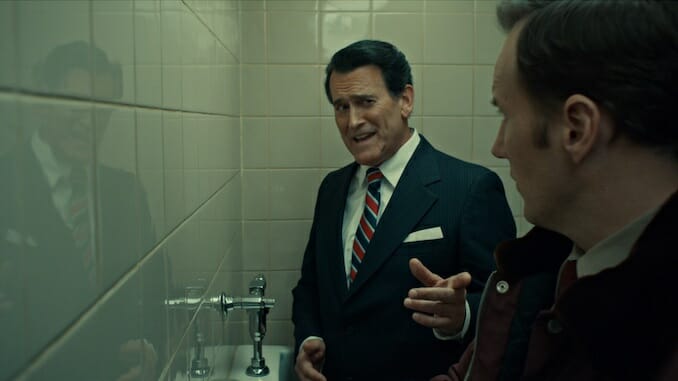Too Big to Fail: How Fargo Tracks the History of America’s Great Economic Scam
Photo Courtesy of FX
FX’s Fargo never had the luxury of being the kind of show that finds its footing in its second year. As such, it spends its first season doggedly proving itself in the broader tonal and narrative strokes of its source material, Joel and Ethan Coen’s 1996 black comedy about a gambler who arranges the kidnapping of his own wife to extort a ransom from his wealthy father-in-law. But with that footing firmly found, Fargo’s Season 2 premiere “Waiting for Dutch” breaks into a giddy sprint, almost the zoomies, with a montage that pairs a flashy new set of editing tricks (which would become instant stylistic identifiers for the show) and a soundtrack of Peter Green-era Fleetwood Mac as a 1979 Jimmy Carter speech warning of a coming recession. With an entirely new cast and a story set 27 years before the first, these first moments of Season 2 are a colorful and confident fresh start, allowing creator and showrunner Noah Hawley to loudly clarify his unique goals for the project in an outside voice. It also lets slip one of the show’s strangest apparent preoccupations: the history of American economics.

Set in the Carter administration’s final year, the season contrasts cold premonitions of a new corporate America with the contemporary atmosphere of tense hopes for Ronald (“Dutch”) Reagan in the face of recession. Reagan makes great fodder for the show, partly because the conceit of his “trickle-down” economic policy was core Fargo: the foolish idea that someone with a million dollars would ever let you see a cent of it. In practice, it would decimate small businesses while overpowering and deregulating only the few largest ones, a consequence the show mimics in its overarching conflict of the losing turf battle between the local crime operation run by the Gerhardt family and the corporately-structured Kansas City crime syndicate that hopes to absorb their business. The Gerhardts are laid to waste in an expansion plan designed by a research department and proposed via slide projector, and in the end Kansas City’s brutal enforcer Mike Milligan (Bokeem Woodbine) gets a promotion to a desk job in a skyscraper.
Season 4’s later reveal that Mike comes from his own family crime business makes his bleak arc, the new vision of economic mobility, even lonelier. For his violent success in destroying the very system he came from, he’s rewarded with a desk job isolated from the groundwork he excelled at and relished as a footsoldier. The American Dream, from here on out, would no longer be one of achievement but instead of climbing a monolithic power structure further and further removed from the work being done. “Every generation has their time,” Reagan muses to Lou Solverson (Patrick Wilson) upon learning he’s a Vietnam veteran. “I remember back in ’42, America just joined the war, I was working on…” He pauses to remember. “Operation: Eagle’s Nest for Paramount.” A few months later, Americans would elect him their leader in a landslide and he would address their economic concerns by ceding their scant economic power to corporations equally far removed from them.
That new dream is also at the heart of the first season, set in 2006, which follows meek insurance salesman Lester Nygaard (Martin Freeman) dodging the consequences of murdering his wife after one too many belittling comparisons to his successful younger brother. The idealization of Chazz Nygaard (Joshua Close), a newly-promoted VP of Sales living with an idyllic family in a modestly oversized house, closely echoes the economic attitudes of the Bush era. At the time, banks’ recklessly expanded lending emphasized an American Dream via oversized homeownership, as a means of projecting economic strength post-9/11. Where the original movie used the image of a modest family home as a symbol of the goodness and justice still left in the world, Lester’s becomes a symbol of the static acceptance of mediocrity that makes him an outcast in an economy propped up by the pursuit of more.
-

-

-

-

-

-

-

-

-

-

-

-

-

-

-

-

-

-

-

-

-

-

-

-

-

-

-

-

-

-

-

-

-

-

-

-

-

-

-

-








































